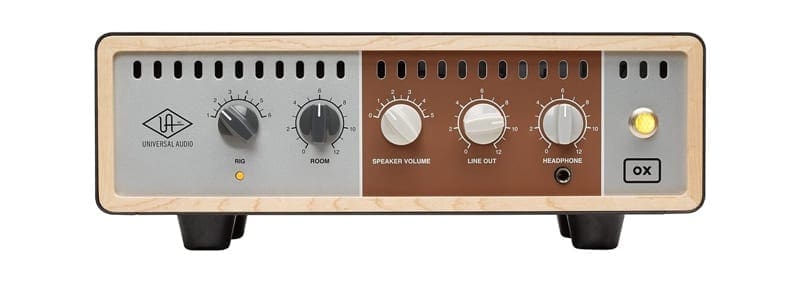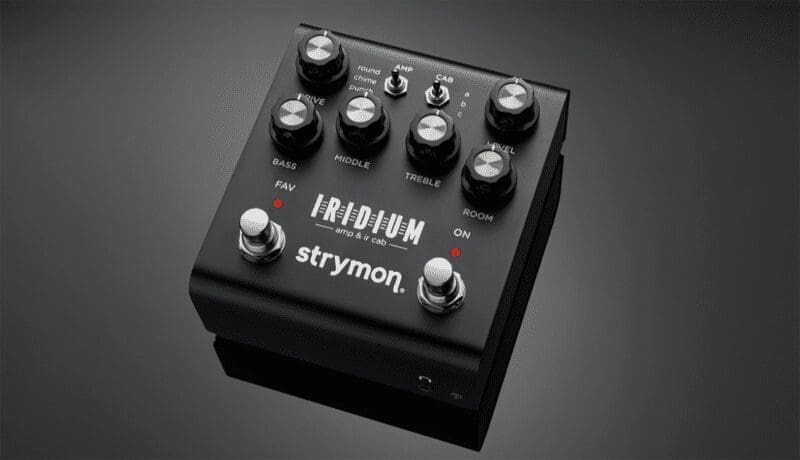Modeling Amps (the use of technology to digitally re-create amps rather than plugging into the real thing) is a fairly controversial, but growing, phenomenon.
On the one hand, you have the purists, the musicians who love their speakers and maintain that amp modellers will always be a watered-down pastiche of the real air-moving speaker cabs we all dearly love.
And on the other hand, you have the advocates of this new technology, experimenting with new sounds and bringing their modellers with them everywhere they go with an easy cost-effective way to have any particular amp you like, from small tube amps to a vox modeling amp.
As a total gear nerd with a love for vintage instruments, my natural position was the former. Clinging lovingly to my old AC30 I initially viewed amp modelers as a sign of technology striping away the unique character of music because you just can’t replicate the real thing.

History of The Modeling Amp
I have a 1981 Fender Rhodes electric piano and you can immediately hear the sound quality of the real thing, even if you compare it to some of the top-end keyboards like the Nord Stage Pianos – the real vintage instruments (compared to the VST Instrumentals) just have something else and so it would stand to reason that the same would be true of Amps and Amp modelers.
However, two events combined and I became a total convert to amp modeling. Firstly, I agreed to play some lap steel on a track for another artist a friend of mine was producing.
I turned up at the studio with my vintage Vox AC30 and my 1950s Gibson lap steel ready to bring the real thing to the record only to have my Producer friend plug my lap steel straight into a Kemper Profiler rack and spin through the different amp options he felt would meet the song, landing ultimately on a 1965 Fender Bassman, and I was totally blown away by how great it sounded.
Secondly, the band’s summer this year got a little busier and we found ourselves playing some larger stages than we had previously.
Usability of the Modling Amp
At the first of these, I took along the Vox and faced an issue I think a lot of electric guitarists have probably encountered – even though it is a lovely amp and sounds great at most live gigs when it was mic’d up and blasted through a huge PA, there was something undeniably boxy about the sound – it was loud but boxy.
Not to mention that I had to faff around a little when deciding if my Banjo should route through my electric guitar amp or straight into the PA and how to manage that headache onstage.
So I took the plunge and brought myself a Kemper Profiler and I haven’t looked back.
The Kemper ensures I have an incredible sound no matter what the venue and I can have different amps for different instruments and different songs all queued up in a ‘Performance’ and ready to go. I love songwriting, inspired by the sound created – awesome!
So the Banjo has a nice Marshall Acoustic amp, my Lap Steel generally runs through a 1965 Fender Champion and my guitar through an old Dumble all with Switchback Cab models – and each one sounds incredible, without the hassle of lots of equipment and the worry of damaging tubes on the road.
Let’s face it, great sounding amps typically involve delicate components.
My journey to finding the best solution for amp modeling took me in a lot of different directions. Here I will compare the top Amp Modelers on the market to give a sense of what is out there and what the best options.
1. The Kemper Profiler

Price – £1400 – £1900 / $1800 – $2400
As mentioned above, this is my modeller of choice and I am very happy with it. But putting that bias aside, the Kemper is an objectively impressive bit of kit.
There are a few different models – an Amp Head (which can be plugged into a speaker cabinet if you still like to push some air on stage), a rack unit, a rack unit with power functionality (for powering external cabs) and the latest addition to the fleet, the Profiler Stage Floorboard – the whole thing in a handy pedalboard format.
I have the rack unit but the Floorboard gets me a little green-eyed.
The great thing about the Kemper is the scope of the thing – it comes with a huge amount of free profiles available through the Rig Manager software, some of them added in by some of the biggest names in the business.
Personally I never stray too far from the Michael Britt (of Lonestar fame) Amp Profiles but there are loads more including Rig Packs from Ace of Skunk Anansie, Lars Luttege and Michael Wagener.
Modeling Amp – Rig Exchange
Rig Manager also gives you access to the Rig Exchange where you can access thousands of amp profiles made by other Kemper users, all rated by a voting system which helps filter out the best ones.
Additionally, you can choose to have your chosen amp sound inclusive of a cab, as a stack or just the amp on it’s own as well as choosing which effects you’d like included (which can also be controlled onstage via a footswitch).
You can store your favourite Amps and effects into ‘Performances’ which is also really handy if you are in multiple bands as you can have a different range of amps for each band eq.
And the clue is in the name of the product, the Kemper Profiler also has a function where you can record your own amps and the Kemper will build a profile of them and store them for you, so you can still take your much-loved vintage power amp sound with you without having to take your much-loved vintage amp!
2. The OxAmp Top Box by Universal Audio

Price £1,100 / $1400
The OxAmp Top box is a really interesting concept and if you are familiar with Universal Audio, you’ll know that they are a company with some absolutely gorgeous products.
The Ox is an analogue reactive load box and guitar amplifier recording system specifically designed for capturing tube modeling amps.
It allows you to position your favourite amps (you can store up to 100 amps models) in their sonic sweet spot and record them with incredible precision. And then you can use them for practising with headphones, live on stage or in a recording studio.
The Ox gives you the flexibility to record a model of your tube amp and then drive the amp hard to get that gorgeous overloading tone, without the fear of damaging it. The Ox is very good at capturing a detailed image of an amp and the UA Dynamic Speaker Modeling emulates speaker drive, breakup and cone cry really effectively.
The OxAmp also comes with a software companion in the Ox App which is a really beautiful audio interface and allows you to control all of the rig settings via a computer or via an iPhone or iPad, which is a really nice touch.
Even better, the Ox can be controlled by Wifi so you don’t need to connect it to a computer or tablet via a cable.
3. Line 6 Helix Floor

Price – £1,144 / $1,470
I remember as a teenager borrowing an early Line6 Pod from a friend and messing around with this strangely-shaped processor that afforded a range of acoustic guitars effects, including reverb delay, some of which sounded great and others that sounded a little odd with a little bit of latency in the range of tones and sound.
In the 15 years since that experience, Line 6 has gone from left-field player to a powerhouse amp and effects manufacturer and the quality of the product has increased tenfold.
The Helix Floor is the flagship guitar processor of the Helix family.
It is a 12-button pedalboard with an expression pedal running across the left-hand side and it’s clear that Line 6 has stayed true to their effects background with 104 different effects pedal models built in.
The Floor (and its studio brother, the Helix Rack) has 62 different amp models, 37 Cabs and 16 microphone options which is a nice touch.
The expression pedal can be configured to have 2 different functions so you can easily switch between high gain Volume and Wah Wah or a combination of amp/or effects parameters by activating the toe switch which is quite a nice feature.
Although it can go wrong if you are on stage and get a little bit heavy-footed in your excitement as I once experienced with a Boss expression pedal!
4. The Strymon Iridium

Price – £399 / $510
The Strymon Iridium is not only the newest player in the amp modeling technology world but it is also by far one of the cheapest alternatives to the likes of the Kemper, OxAmp and Line6.
That said, it is also the most limited in terms of what solid-state amps you can use. If your goal is to get the best guitar amp under 500 bucks, this is your dream ticket.
Rather than trying to capture every amp ever, the Strymon team have chosen to focus the Iridium on 3 classic amps which they call ‘Round’, ‘Chime’ and ‘Punch’, and 9 Cabs.
I must admit, although they’ve only chosen 3, they made some good choices – the ‘Round’ amp is based on a Fender Deluxe Reverb, the ‘Chime’ is a Vox AC30TB and the ‘Punch’ is a Marshall Plexi.
The great thing about the Iridium is that is is easy, it is a large pedal but would fit pretty seamlessly onto most boards and like the Kemper, OxAmp and Line6, it allows you to go straight into the PA, guaranteeing that your sound remains consistent from gig to gig.
In some ways, the limited nature of the modeller is actually a benefit because you aren’t able to drown in a sea of subtly different choices but you have the flexibility to customise your sound. And at a price of £400, I think it is a really strong offering.
5. HeadRush Pedalboard -Modeling Amp

Price – £900 / $1,150
The HeadRush is similar in appearance to the Line6 Helix, although something about it looks a little prettier to me.
It’s probably the 7-Inch touch display that allows you to touch, swipe and drag-and-drop to create and edit rigs very easily and just has a sense of invitation about the user interface which is really cool. It comes with 34 Amps, 15 Cabinets and a host of effects.
You can save your rigs (combinations of Amps and pedals) into performance profiles so the PedalBoard is gig-ready almost out of the box.
Another really nice feature of the Headrush PedalBoard is that it includes a 20 Minute Loop capacity so it can also be used to effect loop effectively if your performance, including anything needed to match to a beat maker.
This is a great practice amp, ideal for classic rock and heavy metal.
So, which is best – what’s our conclusion?
For the budget, the Strymon is great value for money and if you know the sound you like fits into it’s offering, I’d say it is a fantastic option.
However, overall – and I recognise that I may be biased, but I am sticking to my decision – for me the Kemper Profiler is the best amp modeller.
You can make your own amp profiles if you want to capture your own amp sound, but (more importantly for me) you also have the benefit of accessing other combo Amps that have been profiled by other users and professional musicians and producers to the highest standard.
You can update it as you go if better Amp sounds come along, whereas the Line6, Helix and Strymon all have a fixed number of options and the OxAmp relies on your being able to record your own amp effectively which to me makes it more of a tool for Producers than a tool for Guitarists who want options for their sound.
I have tested the Kemper extensively both in the recording studio and on large and small stages and it has consistently performed reliably.
I have had a great sound, which is especially valuable in a festival-type situation where there is usually a shared (relatively knackered) backline and you have very limited time to get on and off-stage but you still want to have ‘your’ sound.
I hope you liked this article if you get a chance please do share it with your fellow musicians’ and friends – Thanks, Pete.










